Projects |
|
The Great Kai’mia Way – by Jo Winkler
In September 2002, a joint project between Sutherland Shire Environment Centre and Georges River Environmental Alliance, funded through the State Government Georges River Foreshore Improvement Program, was launched to examine the feasibility of a regional trails network for Southern Sydney, linking tracks and trails in the Georges and Woronora valleys. |
The project began with a community information and consultation event on Saturday 7th September 2002—“Trails – A People’s Forum”. The day provided a platform for lively discussion of the values and challenges of public access trails, based on the 4 broad themes of movement, heritage, health and biodiversity. The Forum was a valuable opportunity for the wider community to participate right at the inception of the project, sharing ideas and concerns. It also helped identify key people within the community, with valuable contributions to make to the project, in terms of local knowledge and helping with research and promoting the concept.
A Project Strategy has been developed, based on a long-term vision: “The Great Kai’mia Way”. This theme links the 3 distinctive trails for Botany Bay, the Georges, and the Woronora. Kai’mia is the Aboriginal name for the Botany Bay and Georges River Region, and is echoed by the spectacular Gymea Lily (Doryanthes excelsa), which has been adopted as a logo for the project. |
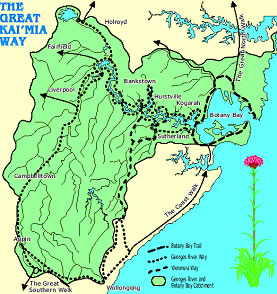 |
The Great Kai’mia Way has the potential to:
- Enhance recreational and educational opportunities of existing open space
- Provide safe traffic free routes linking communities to their surroundings
- Increase community awareness of river and catchment environmental values
- Promote Aboriginal and non Aboriginal heritage
- Encourage active and healthy lifestyles for a wide range of people in the community
- Increase protection of foreshores and bushland in the catchment
- Forster cross community ties between indigenous and non-indigenous groups
- Develop stewardship partnerships between land owners, residents, local Aboriginal Land Councils, agencies and local government
|
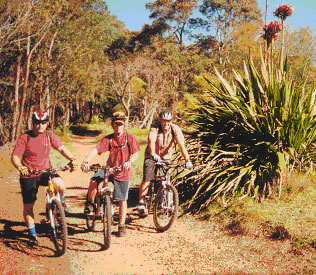 |
| Top of Page |
Advisory Board |
At the most formal level, the team created an advisory board: a quarterly meeting comprising invited representatives of major stakeholders: federal, state and local government agencies, regional non-government organisations (NGOs), natural resource managers, elders and local Aboriginal Land Council representatives.
Each Board meeting was located in a different local government area – a deliberate policy to promote ownership of the project across the catchment.
The major functions of the Advisory Board was to strengthen the partnerships developed over the lifespan of the study through:
- Communication
- Accountability
- Discussion of problem issues
- Integration
|
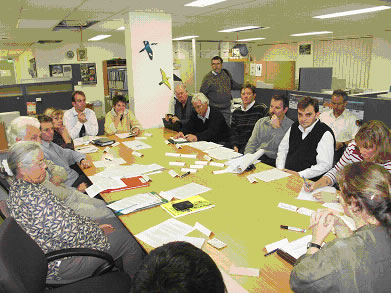 |
| Top of Page |
Community Events |
In order to reach out to as many people as possible, the project team welcomed opportunities to participate in community events.
In March 2003 the project team coordinated a clean up of an abandoned Christian camp on the Woronora River as part of the Australia Day Clean up. Twenty eight people – local residents, Waterways staff, Rural Fire Brigade volunteers and the owner of the local boat shed – participated on the day to dismantle eighteen steel-framed bunk beds, remove mattresses, old tin roofing sheets and collect rubbish. This was no mean feat considering the only access to the site was by boat, and at least three tons of rubbish was removed that day. At one stage of the removal process, the barge nearly sank under the weight of the junk!
|
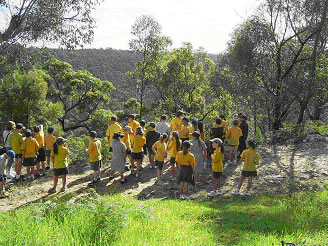 |
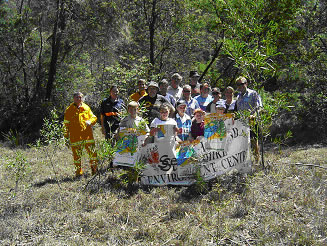 |
The Volunteer Fire Brigade organised a sausage sizzle, and Sutherland Shire Council arranged to have the rubbish taken away. Overall, it was an excellent indicator of how the Kai’mia Way project can generate positive environmental action and community building.
The project team also set up stalls and promoted the Great Kai’mia Way as well as sought feedback at three festivals organised in the Sutherland Shire area: Menai Celtic Festival, Sutherland Shire Council School Environment Fair and Naidoc Day. |
| Top of Page |
Stakeholder Contributions
These stakeholders helped plan the routes, identify the issues and suggest enhancements and solutions to problems. It was clear that in a number of areas, stakeholders had already given a great deal of thought to planning of a route. The Great Kai’mia Way proved a welcome vehicle to enable them to gain recognition and for delivering outcomes. The Burnum Burnum Track, the Sandy Point Progress Association, Friends of Prospect Creek, Bankstown Bushland Society and Friends of Yeramba Lagoon.
From its inception, the Great Kai’mia Way project promised to be a grand vision with the potential for achieving many environmental, heritage and recreational objectives. As the project unfolded, the promise was reflected by the enthusiasm with which many stakeholders participated in information gathering and decision-making. Without doubt, implementation of the Great Kai’mia Way is an initiative that has come of age. |
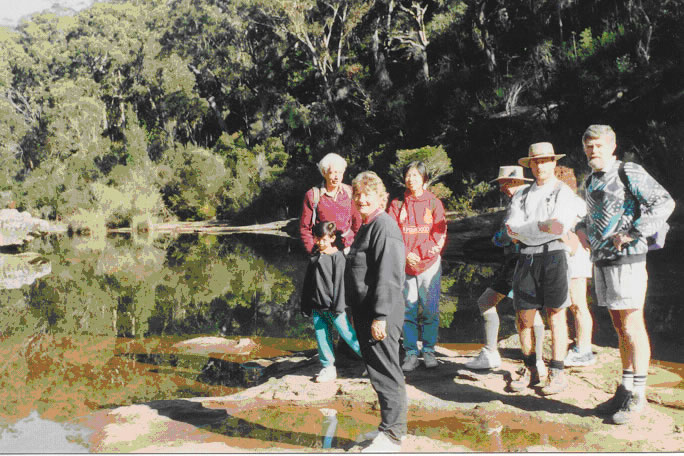 |
| Top of Page |
A Community Garden for Sutherland
The Environment Centre’s work is sustainability-focussed. The challenge has always been, and continues to be, how to make sustainability relevant to all – government, business and community. The development of a community garden in Sutherland promises to do just that…
The Environment Centre was approached in November 2002 to auspice a group looking to set up a community garden in Sutherland Shire. There was initial enthusiasm from about 30 individuals, and the Menai Youth Centre was suggested as a site for the garden. However, it soon became apparent this was not going to be suitable in the long term, and interest soon waned.
Not deterred easily, a few diehards remained, and started scouting around for another potential site. As part of this search, contact was made with Sutherland Shire Council’s Community Services. The garden group was told that Council had wanted to get a community garden up and running for a few years, but shifting priorities had meant it had never gone past the proposal stage. At the same time, the group was also informed of Council’s Sustainable House project – a Council-owned property in Sutherland that is being flagged for conversion into a demonstration sustainable house. This property, next to the Leisure Centre and PCYC, has a large, empty garden and more unused land in its immediate vicinity.
In June 2003, the garden group wrote a proposal to Council for a community garden, based on permaculture principles, encompassing fruit, vegetables and native plants, to be established on this property, with a view to its integration into the Sustainable House project. The proposal went before Council Directors in July, then before Council on August 11th, and was given in-principle support, pending approval of $5,000 funding from the EPA’s Eco-friendly Communities program.
In mid-August the funding was approved, and the rallying of the troops has begun! Contact has been made with local neighbourhood centres (Crossroads Community Care, Miranda; Menai Community Resource Centre; Engadine Precinct Community Aid and Information Service), the PCYC, the horticulture department of Padstow TAFE, and staff from various Council departments (Bushcare, Waste Services, Environment & Health, Science and Property). This may be the tip of the iceberg… However, those involved so far have nominated to work united towards a common goal: encouraging active participation of community members in sustainable lifestyle practices, and instilling a sense of ownership and responsibility for the environment throughout government, business and the community. |
| Top of Page |
Outreach/Library Report
The mission to educate the masses on ecological sustainability continues…
In February 2003, the NSW Environmental Education Plan (Learning for Sustainability) was launched. The plan’s vision is to achieve “Effective and integrated environmental education which builds the capacity of the people of NSW to be informed and active participants in moving society towards sustainability”.
Currently, the Centre is working on strategies to improve our outreach capabilities and in turn, build community capacity for taking responsibility for their local environments. We are looking to use the plan as part of our efforts to achieve the community capacity building targets set by the Southern Catchment Management Board’s Blueprint.
Strategies being considered include:
- extending the website to be more interactive and contain more information;
- creating local issue education kits for teachers to integrate into their teaching plans,
- becoming a directory for environmental issues (i.e. building networks/relationships with other members of the environmental industry so that when enquiries come our way, we can quickly point them in the right direction, rather than the pressure being on us to know everything);
- making our resource library more widely accessible.
As we don’t currently have the resources to be a fully functioning library, our library co-ordinator Becky has been investigating options to link our resources online to other libraries. Options to be looked at include:
- Becoming a group of the Australian Library and Information Association;
- Linking our library to school library systems; and
- Linking our library to university library systems.
Becky has also conducted interviews with staff from the Total Environment Centre and the Nature Conservation Council to find out how they manage their information resources.
Sutherland library has been approached to consider the possibility of linking with their online system. Unfortunately, they weren’t very keen as we don’t provide enough different material to what they already have. However, they have provided a link to our website on their website. They have suggested we put our catalogue up on our own website, and concentrate on keeping our materials unique – collecting industry reports and books rather than periodicals and journals, which are in vast supply at Sutherland library. |
| Top of Page |
National Tree Day 27th July 2003
SSEC became involved in National Tree Day this year – a result of partnerships built through the Great Kai’mia Way project. |
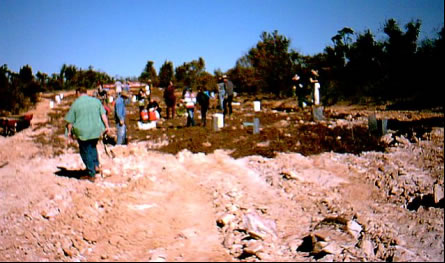 |
The Gandangara Local Aboriginal Land Council have long been fighting illegal trail bike and 4WD use on their land near Lucas Heights. The trail bikes and 4WDs have degraded large sections of the land, damaging plants, disturbing the fauna, causing soil erosion, which, in turn, has lead to the siltation of Mill Creek. Aside from the physical damage, the spiritual and cultural significance of the place is threatened by these activities, as it disrespects the complex relationship between the Aboriginal community and ‘country’.
In an effort to increase understanding within the wider community of the importance of the conservation of Gandangara land, the Environment Centre proposed a tree planting on one of the more degraded sites to coincide with National Tree Day.
Gandangara LALC were very enthusiastic, and a local 4WD club that had been performing regular clean-ups on the land were engaged to help co-ordinate the day. The NSW Waste Services nursery at Lucas Heights very kindly donated 300 plants, all indigenous native species (including Angophora costada, Lomandra longifolia, Viminaria juncea). Sutherland Shire Council donated the use of an earth-mover prior to the day, to break up the hardened soil to make it was ready for planting.
On the day, we had 39 volunteers show up, including local Menai MP, Alison Megarrity and her two sons. In no time at all, 300 plants were in the ground, and the Gandangara rangers set up temporary barriers around the regeneration site to deter unwelcome interference. Quite a few children were involved on the day, not only helping to plant, but also collecting Banksia seeds from the surrounding bush and scattering them around the newly regenerated area. A barbeque organised by the Gandangara LALC was enjoyed afterwards by all.
The day really did work to unify different community groups. It must be understood that the actions of the tree day do not fix the damage that has already been done. What we hope it has achieved is improved communication between stakeholders and an understanding that biodiversity conservation is everyone’s responsibility.
Special thanks to: Tom McLoughlin (SSEC volunteer), Robbie Bell (Gandangara LALC), Hemmi Voges (Suzuki 4WD Club) & Christine (NSW Waste Services Nursery). |
| Top of Page |
SSEC Newsletter
Aside from our website, SSEC’s newsletter, The Centre, continues to be one of our primary methods of communicating with our members and associates about our activities.
A small but dedicated number of contributors have produced some very enlightening and enjoyable reading. We’ve had articles on the often-overlooked impacts of light pollution, an insight into Genetically Modified crops, the ins and outs of beach cleaning, as well as commentary on current local issues, such as our Transport Vision, the People’s LEP, the Great Kai’mia Way and the ever-controversial Kurnell Peninsula.
Many thanks to Vicki Simpson and Miriam Verbeek for their consistent and enthusiastic involvement, and to Pam Cook, Don Page, Ian Jeffrey and Bob Walshe for their contributions this year.
New contributors are always welcome!! |
| Top of Page |
Policies and Procedures
The Centre has continued its process of developing and writing more policies and procedures. We currently have the following in development or completed: |
- Aboriginal Interests
- Air Pollution
- Resource Use and Population
- Community Participation in Decisions
- Electromagnetic Radiation (EMR)
- Energy Conservation
- Genetic Engineering
- Greenhouse Issues
- Loss of Regional Biodiversity
- Marine Pollution Issues
- Mining and Use of Uranium
|
- Nuclear Issues
- Coastal Issues
- River Issues
- Soils and Their Conservation
- Threatened Species
- Tourism Issues
- Toxic and Hazardous Waste
- Transportation Issues
- Urban Bushland
- Urban Development
- Waste Minimisation
- Water, Sewerage
- Wetland Conservation
|
| All of SSEC’s policies and procedures are documents that will change as deemed necessary after careful consideration by the Management Committee. |
| Top of Page |
Constitution
This year there are proposed changes to SSEC’s constitution. The Management Committee requests that the membership vote on the following Special Resolution*
The purpose of the changes are to constitutionally reflect the Centre’s existing practice of open government in it’s decision making processes.
A member can nominate to become a member of the Board and accept the legal responsibilities and liabilities that come with managing an association under the Associations Incorporation Act 1984 and the Associations Incorporation Regulation 1985.
A member can nominate to become a member of the Management Committee and assist through open government and delegation, the Board in governing the association without consenting to the legal responsibilities and liabilities that come with managing an association under the Associations Incorporation Act 1984 and the Associations Incorporation Regulation 1985
General Revisions
- In regard to the Management Committee being renamed as the Board and adopting all Management Committee responsibilities held prior to 5 September 2003, make changes to the Centre’s Constitution in:
- Part I: Preliminary, Rule 4 Interpretations
- Part II: Membership, Rule 13 Disciplining Members
- Part III: Board, Rule 14 Powers
- Part III: Board, Rule 15 Constitution and Membership
- Part III: Board, Rule 16 Election of Office?bearers, Board and the Management Committee
- Part III: Board, Rule 17 Secretary
- Part III: Board, Rule 19 Casual Vacancies
- Part III: Board, Rule 20 Payment etc. of Members and Office?bearers
- Part III: Board, Rule 21 Delegation by the Board
- Part III: Board, Rule 22 Meetings and Quorum
- Part IV: General Meetings, Rule 24 Annual General Meetings ? Calling of and Business at
- Part IV: General Meetings, Rule 25 General Meetings ? Calling of and Procedure
- Part IV: General Meetings, Rule 26 Special Resolution
- Part V: Miscellaneous, Rule 28 Funds –Source
- Part V: Miscellaneous, Rule 29 Funds –Management
- Part V: Miscellaneous, Rule 30 Funds –Audit
- Part V: Miscellaneous, Rule 31 Funds – Common Seal
- Part V: Miscellaneous, Rule 32 Funds – Surplus Property
- Annexure A: Rules of the Sutherland Shire Environment Centre Public Gift Fund
- Add a new committee to be named the Management Committee to assist the Board in governing the association.
* N.B. The full Constitution will be on display at the AGM and is also available at the SSEC’s office in Merton St, Sutherland. |
| Top of Page |
Volunteers
This year community volunteers continued to be active and committed. Our volunteers each deserve a special thanks. Our organisation and the community have greatly benefited from their efforts.This year I would like to pay a special tribute to Ruth Zeibots
In a very busy year, the extra effort Ruth has put into the events committee is evidenced by the significant contribution her team has made to the Centre’s finances. Therefore on behalf of the Management Committee, I enthusiastically commend Ruth for her energetic role as a model community volunteer. Not only has Ruth been very active in organising the street stalls, she organised another Waste Art Competition with local schools with over 100 participants. |
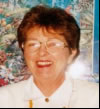
Ruth Zeibots |
| The Centre succeeds because of our volunteers, so I take my hat of to each of you, Ruth Zeibots, Bob Walshe, Joan Flowers, Shirley Renshall, Ruth Turner, Michael Priceman, John Nelson, Don Page, Ann Long, Michael Nancarrow, Les Bursill, Adrian Palmer, Neil deNett, Tim Tapsell, Michelle Zeibots, Lyn McLean, John Lincoln, Don …., Ted Lawes, Arron Skelsey, Renate Brenner, Ian Jeffrey, Petronella Mauunga, Adam Wilkinson, Maree Kalatzis, Kathy Tian, Kathy Hall, Julian Cooper, Sapna Kamath, Tom McLoughlin, Byron Crane, Becky Lo, Zana Jancic, Robert Koppe, Garth Holmes, Lenka Mutkovic, Steve Lussick, Jin Teng, Fiona Ottow, Jeff Woo, John Vlamitsopoulos, Theo Giameos, and the many many participants in our Cleanup Australia Day activities, our trials project field volunteers, … you do your community proud. |
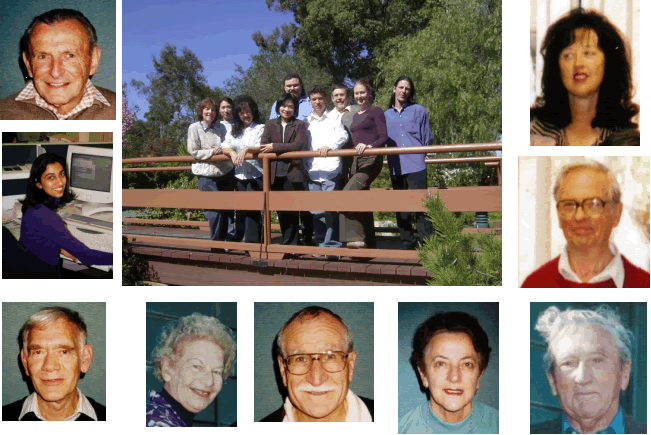 |
| Top of Page |
Staff
The Centre has had four full-time and two part-time staff for most of the past year. We currently have Jim Sloan (Executive Officer), Josephine Winkler (Office Manager), Becky Lo (Volunteer and Library Coordinator), Nick Benson (Woronora Trails coordinator) and Bob Symington (Georges River Trails coordinator).
Simon Kimberley (Science Officer and WebMaster) for the past four years left us in September 2002 for new challenges. Lorraine Foster (Volunteer and Library Coordinator) left us in November 2002 to take up a librarian position in the city and Michelle Zeibots (Transport Coordinator) left us in February 2003 to focus on her PHD. My thanks to each of them they have been a pleasure to work with and I wish them all well in their new endeavours. |
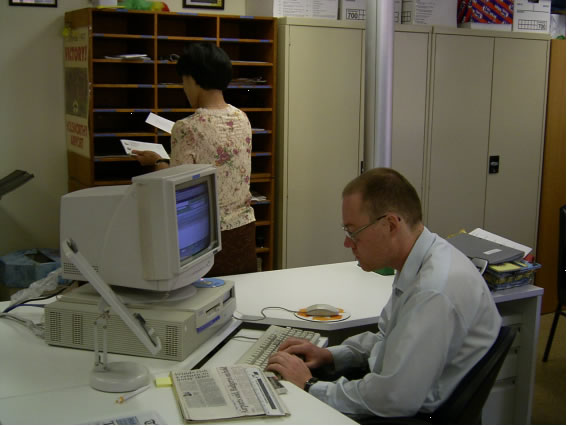 |
| Top of Page |
|



